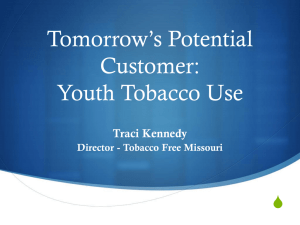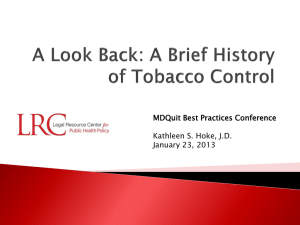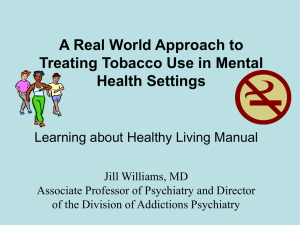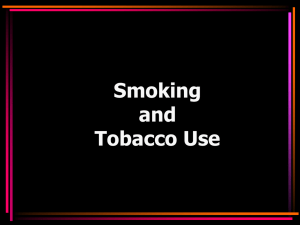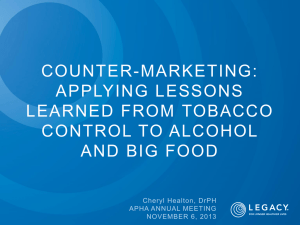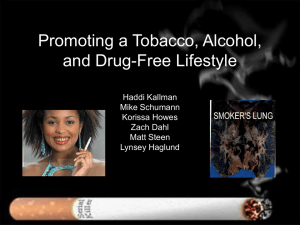Eric Lindblom - Institute of Medicine
advertisement
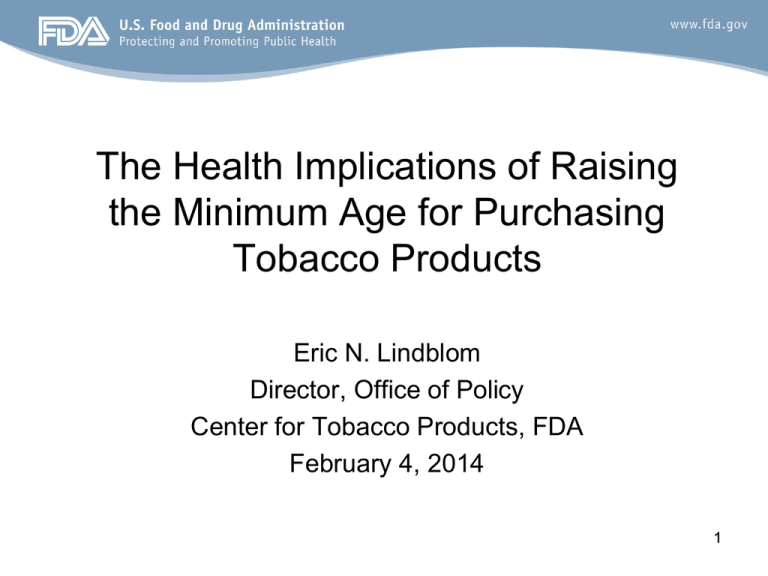
The Health Implications of Raising the Minimum Age for Purchasing Tobacco Products Eric N. Lindblom Director, Office of Policy Center for Tobacco Products, FDA February 4, 2014 1 Tobacco Use in the United States • Leading preventable cause of death in the United States • At least 480,000 premature deaths yearly from cigarette smoking and exposure to secondhand smoke; • 8.6 million Americans have 12.7 million smoking-attributable serious medical conditions • Lost productivity and increased direct health care costs from smoking and exposure to secondhand smoke total more than $289 billion per year. • Despite significant declines during the past 30 years, cigarette smoking among adults in the United States remains widespread, and year-to-year decreases in prevalence have been relatively small recently. 2 Youth Tobacco Use in the USA • Due to the slow declines in smoking rates, if we continue on the current trajectory 5.6 million children alive today will die prematurely due to smoking – Nearly 2.4 million (14%) of high school students report current use – Every day, more than 3,200 kids under 18 smoke their first cigarette and more than 700 other youth under 18 become daily cigarette smokers – Nearly nine out of ten (87%) of daily adult smokers tried the first cigarette by 18 years of age 3 Youth Access • 14% of high school smokers (less than 18 years of age) report usually obtaining their own cigarettes by buying them in a store or gas station (Youth Risk Behavioral Surveillance System 2011) • Half of 8th graders (49.9%) and seven out of ten 10th graders (71.4%) report cigarettes being fairly easy or very easy to obtain (Monitoring the Future 2013) 4 The Tobacco Control Act Gives FDA/CTP Extensive Authority • Recognizes FDA as the “primary Federal regulatory authority with respect to the manufacture, marketing and distribution of tobacco products” • Gives FDA authority to directly regulate cigarettes, smokeless tobacco products, RYO and cigarette tobacco • Grants FDA authority to put all other products made or derived from tobacco intended for human consumption (but not those used for medical treatment of nicotine addiction) under its active tobacco product jurisdiction. 5 FDA’s Current Efforts to Prevent Sales to Youth Rule issued pursuant to the Tobacco Control Act prohibits sales of cigarettes, smokeless, RYO to persons under the age of 18 and requires sellers to check the age and ID of anyone under the age of 27. 6 FDA/CTP Retail Inspections & Enforcement • Inspection/compliance contracts with 45 states/territories • Direct FDA inspections in jurisdictions w/o contracts (e.g., NY, FL) • More than 249,000 inspections of tobacco retailers; 12,600 warning letters and 1160 Civil Money Penalties (as of 1/1/14). 7 But the Tobacco Control Act Prohibits FDA From Raising the Minimum Age No FDA restrictions on the sale and distribution of tobacco products may “establish a minimum age of sale of tobacco products to any person older than 18 years of age.” [Sec. 906(d)(3)(ii)] 8 Instead, the Tobacco Control Act instructs FDA to: 1. Convene an expert panel to conduct a study on the public health implications of raising the minimum age to purchase tobacco products; and 2. Not later than 5 years after the date of enactment of this Act [4/1/15], submit a report to the Congress on the results of such as study. [Sec. 104] 9 Project’s Statement of Task: The Institute of Medicine (IOM) shall establish a committee of public health, medical and other experts to advise the FDA/Center for Tobacco Products (CTP) on the likely public health impact of raising the minimum age for purchasing tobacco products. The committee shall develop a consensus study based on their findings, which the CTP will use as a basis for creating their report to Congress. The IOM shall: • Examine existing literature on tobacco use initiation; and • Use modeling and other methods, as appropriate, to predict the likely public health outcomes of raising the minimum age for purchase of tobacco products to 21 years and 25 years. 10 Task Order with IOM also states that: • The study will also serve to inform state and local governments considering raising the minimum age. • The committee shall obtain input from a wide range of stakeholders including federal agencies, health care industry, tobacco industry, academicians, and the public. * * * * * To make the report as useful as possible to Congress, state and local governments, FDA, and the range of interested stakeholders, the following questions could be considered: 11 What are the likely different public health impacts from raising the minimum age to purchase tobacco products? In particular, to what extent would raising the minimum age: – Reduce (or delay) initiation? Among which age groups? – Affect cessation (e.g., among existing smokers no longer of legal age)? 12 What different public health benefits would likely come from raising the minimum age to different levels. For example: – Would a disproportionate portion of the potential benefits be secured from raising the minimum age just to 19 (beyond high school), compared to some higher age? – Are there significantly diminishing or increasing returns from raising the age to higher levels? – Would phasing in a higher minimum age (e.g., no current legal smokers affected) significantly reduce overall benefits? 13 • Does raising the minimum age in a single town (or single state) secure significant benefits – or just move sales to other nearby jurisdictions with lower minimum age laws? • Minimum age laws typically prohibit tobacco product sales to persons under a certain age. How does that approach compare to prohibiting persons under the stated age from purchasing or possessing tobacco products? • To maximize public health benefits from raising the minimum age, how important are severity of penalties, and related inspections and enforcement,? 14 There is not a lot of published research directly on point to help answer these and other relevant questions. So we encourage the Committee also to consider: • What can be learned from the experiences of states and localities (or other countries) with raised minimum age laws for tobacco products -- or for other products? • What do the past U.S. reductions in the minimum age for alcohol from 21 to 18, and the subsequent return to 21, tell us that might be relevant regarding the minimum age for tobacco products? • Is available research on brain and emotional development among youth and young adults relevant to whether the minimum age should be increased to some higher age? 15 Some Guidelines • The Committee should identify the research, data and other evidence used to inform its analysis and conclusions – and also identify any key research gaps. • The Committee should clearly identify any cited references or other information considered by the Committee that were provided by, or funded by, any parties that would be directly affected by a change in the minimum age for purchasing tobacco products, such as sellers or manufacturers of tobacco products. 16 Thanks for taking on this interesting and important project. Questions? 17



